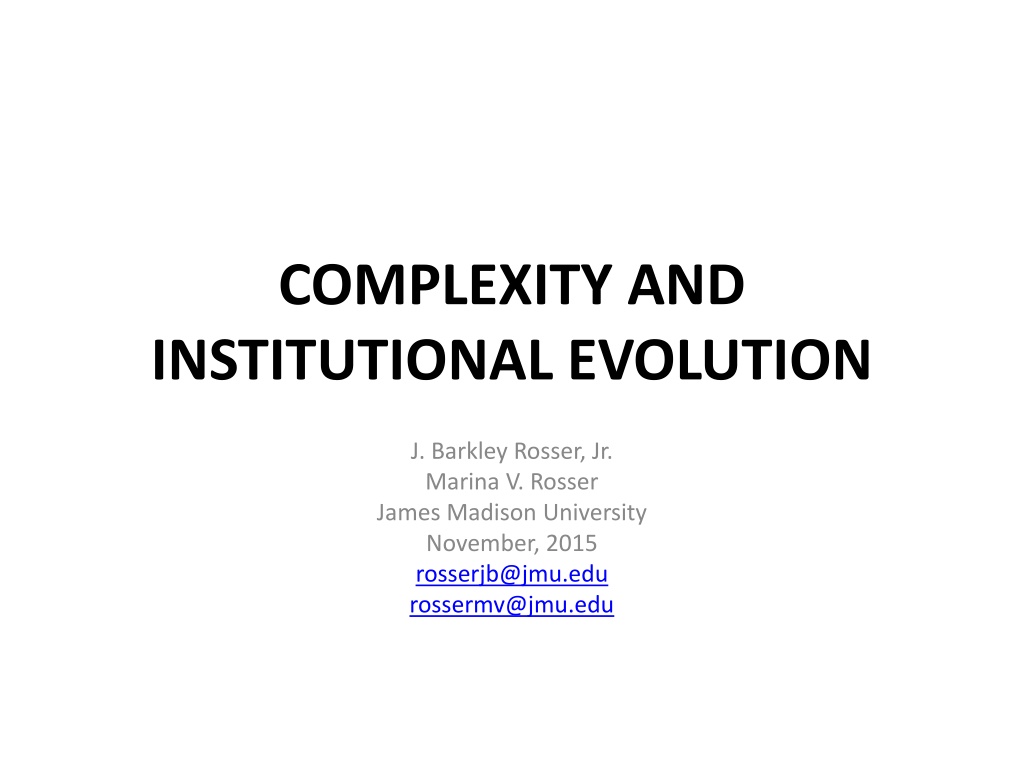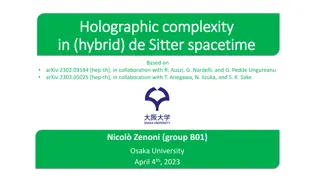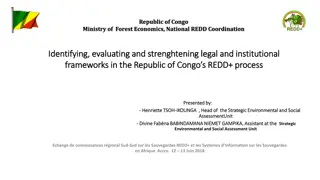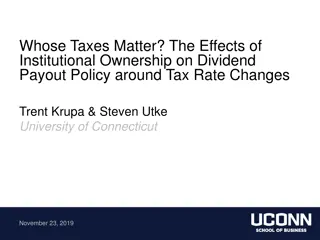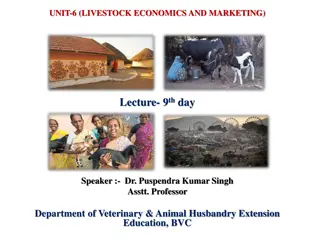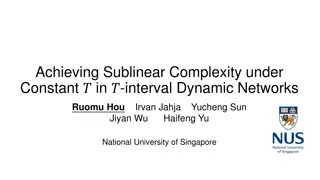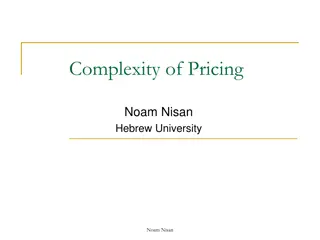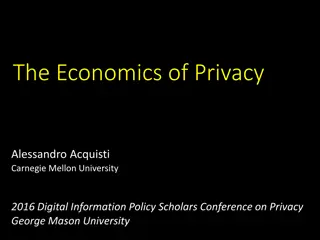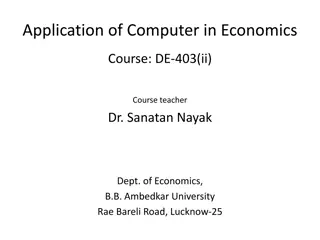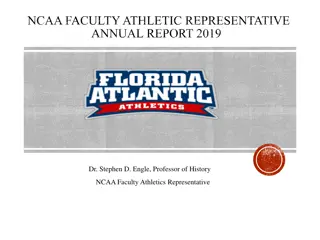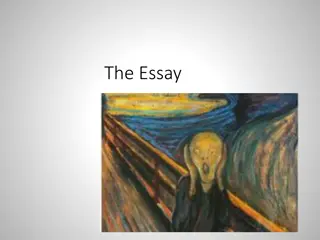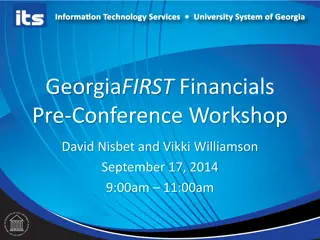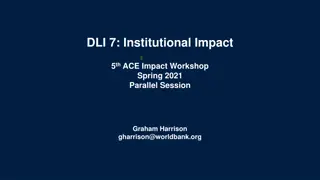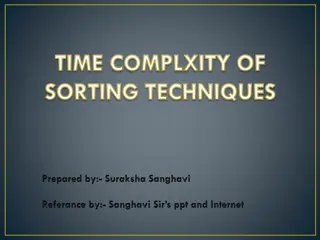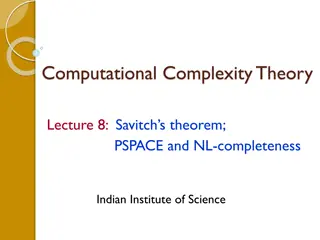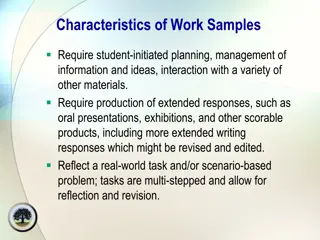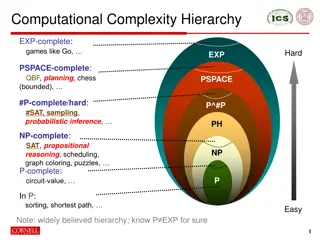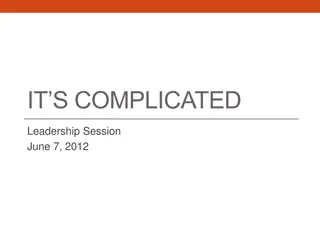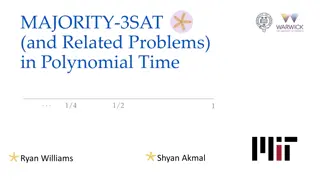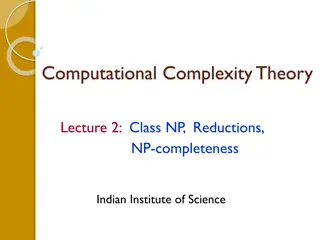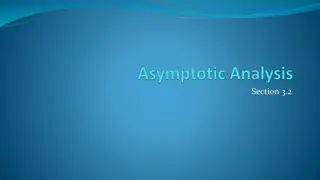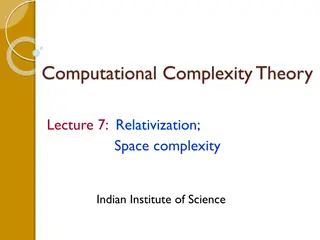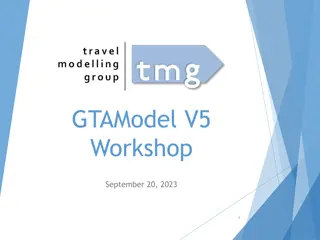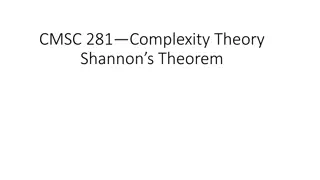Complexity and Institutional Evolution in Economics
This paper explores the relevance of complexity theory in studying economic institutional evolution, focusing on the concepts of cumulative causation, increasing returns, and hierarchical emergence. It discusses the dynamic and computational complexity theories, highlighting the role of systems following erratic patterns and qualitative levels of difficulty in problem-solving. The historical perspectives of Veblen, Commons, and Schumpeter in the evolutionary economics domain are also analyzed.
- Complexity Theory
- Institutional Evolution
- Economic Dynamics
- Computational Complexity
- Evolutionary Economics
Download Presentation

Please find below an Image/Link to download the presentation.
The content on the website is provided AS IS for your information and personal use only. It may not be sold, licensed, or shared on other websites without obtaining consent from the author. Download presentation by click this link. If you encounter any issues during the download, it is possible that the publisher has removed the file from their server.
E N D
Presentation Transcript
COMPLEXITY AND INSTITUTIONAL EVOLUTION J. Barkley Rosser, Jr. Marina V. Rosser James Madison University November, 2015 rosserjb@jmu.edu rossermv@jmu.edu
Abstract This paper shows which portions of complexity theory are most relevant for studying economic institutional evolution. This question leads to both the two main competing economics complexity theories: dynamic and computational complexity. Central to this is the concept of cumulative causation, invented by a main founder of institutional economics, Thorstein Veblen, a fact not widely recognized. This provides the basis for increasing returns, multiple equilibria, and bifurcations in the evolution of institutions. A central issue in institutional evolution involves hierarchical emergence, with the interaction of spontaneous emergence with natural selection a central issue. Recognizing these issues may provide a new synthesis of the old and new institutional economics.
Relevant Forms of Complexity Among the many identified forms of complexity (at least 44 according to Seth Lloyd), the most widely used in economics are dynamic (Day; Rosser) and computational (Velupillai; Axtell, 2005). The former involves systems endogenously following erratic patterns not converging on equilibrium or steady growth. Computational complexity involves qualitative levels of difficulty in solving programs. Both of these are relevant to problems of institutional evolution, which are dynamic, but also can involve emergence arising from failures to solve problems at a given level.
Veblen and Cumulative Causation Veblen (1898) famously argued that economics should be an evolutionary science. From the beginning he identified this as involving the evolution of institutions, with the main group of old institutionalist economists known as the Association for Evolutionary Economics, reflecting Veblen s influence. ] Despite this being forgotten by most of the profession, many sources identify either Allyn Young (1928) or Gunnar Myrdal (1957) as coiners of cumulative causation, which always implied increasing returns. But, from 1898, Cumulative causation leaves no place for a formulation of natural laws in terms of definitive normality, whether in economics or in any other branch of inquiry (p. 378), and An evolutionary economics must be the theory of a cumulative sequence of economic institutions stated in terms of the process itself (p. 393).
Veblens Relation with Commons and Schumpeter T. Papageorgiu, I.Katselidis, and P. Michaelides in (2013) argue that those first two leaders of American (old) institutional economics share views with evolutionary economist, Schumpeter, particularly their view that evolutionary economic change is not an equilibrium process. Veblen and Schumpeter share an emphasis on technological change as a driving evolutionary force, which has no definite direction, even as Schumpeter criticized institutional economics. Commons had a more teleological view than either Veblen or Schumpeter. For Veblen, the Darwinian scheme of thought is of blindly cumulative causation, in which there is no trend, not final term, no consummation. (1907, p. 304)
Veblen and Schumpeter on Evolution Continuous or Discontinuous? Major area of dispute in evolutionary theory between continuous and saltationalist (discontinuous) theories of evolution. In biology, Darwin leader of continuity school, with Gould and Eldredge arguing for punctuated equilibria. Marshall followed Darwin, with natura non facit saltum, although he did not discuss institutional evolution per se. Marshall emphasized competition among firms, revived as evolutionary view by Alchian (1950). Schumpeter supported saltationalist view in technology. Veblen agreed on technology and at crucial points for institutional evolution.
Veblen on Crises in Institutional Evolution Not only is the individual s conduct hedged about and directed by his habitual relations to his fellows in the group, but these relations, being of an institutional character, vary as the ways and means, the amplitude and drift of the individual s conduct are functions of an institutional variable that is of a highly complex and wholly unstable character. (Veblen, 1919, pp. 242-243)
Increasing Returns in Social Interactions and Multiple Equilibria W. Brian Arthur (1994) long argued increasing returns can bring complexity. Model of Arthur, Ermoliev, and Kaniovski (1987) offers key for social interactions leading to multiple equilibria in institutions. Applied by Minniti (1995) to crime, whether society mostly criminal or not. Rosser, Rosser, and Ahmed (2003) apply model to study of shadow economies in transition, again with multiple equilibria and thus critical bifurcations.
Role of Fitness Landscapes The analytical framework: Fitness landscapes due to Sewall Wright (1932). Multiple local hills (optima) recognized by Wright, studied later by Kauffman (1993), with complexity catastrophe arising as more dimensions arise. Applied to institutional evolution by Mueller (2014). While Wright hated emergence idea, Gouldian discontinuities inherent in rugged landscapes.
Institutions and Organizations While much debated, it is generally argued that institutions and organizations are not the same (North, Williamson). Organizations are decision making hierarchical structures specifically created by groups of humans. Institutions are practices or customs that persist over time, often with cultural embedding. Legal systems and broader economic systems also fit in. They are the memes that evolve in evolutionary institutional economics (North and Winter, 1982).
Ostrom and Cooperative Institutions Ostrom (1990) provides study of cooperative institutions for management of commons resources subject to prisoner s dilemma. Sethi and Somanathan (1996) provide conditions for Nash equilibria, with multiple equilibria, some destructive, some supportive, of sustainable development. Rosser and Rosser (2006) extend this argument.
Cooperation and Emergence of Multi- Level Evolution Henrich (2004) on cultural group selection. Crow (1955) and the Hamilton-Price equations, conditions depend on in-group versus out-group variance, with variability, selection, and inheritance keys to evolution (Hodgson and Knutsen, 2006). Eigen and Schuster (1979) provide key through information preservation in emergence of higher levels in hypercycle. See also Kauffman (1993).
Eigen and Schusters Condition for the Hypercycle (1979) Let Vm be the number of symbols, m > 1 be the degree of superiority of the master copy in selective advantage, and qm be the quality of symbol copying. Then the threshold of information content above which copying will degenerate due to an error catastrophe is given by Vm < ln m/(1- qm).
Crows Condition for Multi-Level Evolution (Crow, 1955) Let Bw be the within-group genic regression on the fitness value of a trait as defined by Wright (1951); Bb be the between-group genic regression to the fitness value, Vw be the within-group variance across individuals, and Vb be the across-group variance. Given that we expect Bw to be negative and Bb to be positive, a sufficient condition for an altruistic trait to increase in a population is given by Bb/(-Bw) > Vw/Vb.
Emergence and Natural Selection Issue raised by Simon (1962) and discussed by Rosser (2014) and Rosser and Rosser (2015). Linked to old British emergentism dating from Mill (1843) and heteropathic laws, Lewes (1875) and in evolution, Morgan (1923), repudiated by neo-Darwinian synthesis, including Wright, despite doubts by Haldane.
Hayek and Evolutionary Emergence Hayek(1951, 1967, 1988) allowed for emergence in psychology and then in economic evolution of institutions. Lewis (2012, 2015) on this. Role of systems theory, especially von Bertalanffy (1950, 1969). Hidden link through Wiener and cybernetics with earlier universal system of organizations, aka tektology of Bogdanov (1902, 1980). See also Stokes (1995). Cybernetics early form of dynamic complexity.
Neo-Schumpeterian Views on Emergence of Institutional Evolution Nelson and Winter (1982) as focusing on memes of practices ( memes due to Dawkins and his universal Darwinism, Hodgson and Knutsen, 2006).In philosophy Gerard? Meso-economics and emergence of institutions in neo-Schumpeterian evolution (Dopfer, Foster, Potts, 2004).
Resolution of Old and New Institutional Economics Veblen cumulative causation implies complex dynamic, even if Veblen not fully aware of it. Commons (1934) father of importance of idea of transaction, point recognized by Coase (1937) and his champion, Williamson. While Coase not aware of it or supportive, search for minimizing transaction cost can be lead evolutionary dynamic and complexity (Mikami, 2011).
Epistemic Issues and Institutional Hierarchic Emergence Epistemic issues can arise from asymmetric information but also from computational complexity (Koppl and Rosser, 2002; Koppl et al, 2015). Hierarchies of computational complexity associated with information structures of institutions can lead to emergence of higher level institutions as bifurcations occur in such systems. Evolutionary competition between such systems, such as different forms of markets, can also have such hierarchies as in the markomata theory of Mirowski (2007).
Partial Bibliography Arthur, W.B., Y. Ermoliev, Y. Kaniovski, 1987, Path-dependent processes and emergent macro- structure, European Journal of Operational Research Axtell, R., 2005, The complexity of exchange, Economic Journal Bertalanffy, L. von, 1950, The theory of open systems in physics and biology, Science Bogdanov, A.A., 1902, The Development of Life in Nature and Society Crow, J.F., 1955, General theory of population genetics: synthesis, Cold Spring Harbor Symposia on Quantitative Biology Dopfer, K., J. Foster, J. Potts, Micro meso macro, Journal of Evolutionary Economics Hayek, F.A., 1988, The Fatal Conceit: The Errors of Socialism Hodgson, G.M. and T. Knutsen, 2006, Why we need a generalized Darwinism and why a generalized Darwinism is not enough, Journal of Economic Behavior and Organization Kauffman, S.A., 1993, The Origins of Order: Self-Organization and Selection in Evolution Koppl, R. and J.B. Rosser, Jr., 2002, All that I have to say has already crossed your mind, Metroeconomica
More Bibliography Lewis, P.A., 2012, Emergent properties in the work of F.A. Hayek, Journal of Economic Behavior and Organization Mikami, M. 2011, Evolutionary aspects of Coasean economics, Evolutionary and Institutional Economics Review Mill, J.S., 1843, A System of Logic: Ratiocinative and Inductive Minniti, M. 1995, Membership has its privileges: Old and new mafia organizations, Comparative Economic Studies Mirowski, P., 2007, Markets come to bits: Evolution, computation, and markomata in economic science, Journal of Economic Behavior and Organization Mueller, B. 2014, Beliefs and the persistence of inefficient institutions, University of Brasilia, Working paper Nelson, R.R. and S.G. Winter, 1982, An Evolutionary Theory of Economic Change Papageorgiou, T., I. Katselides, P.G. Michaelides, 2013, Schumpeter, Commons, and Veblen on Institutions, American Journal of Economics and Sociology
More Bibliography Rosser, J.B., Jr., 2014, Natural selection versus emergent self-organization in evolutionary political economy, in Entangled Poliltical Economy Rosser, J.B., Jr., M.V. Rosser, 2006, Institutional evolution of environmental management under economic growth, Journal of Economic Issues Rosser, J.B., Jr., M.V. Rosser, E. Ahmed, 2003, Multiple unofficial economy equilibria and income distribution dynamics in systemic transistion, Journal of Post Keynesian Economics Sethi, R. and E. Somanathan, 1996, The evolution of social norms, American Economic Review Simon, H.A. 1962, The architecture of complexity, Proceedings of the American Philosophical Society Veblen, T. 1898, Why is economics not an evolutionary science? Quarterly Journal of Economics Veblen, T. 1907, The socialist economics of Karl Mars and his followers II: the later Marxism, Quarterly Journal of Economics
